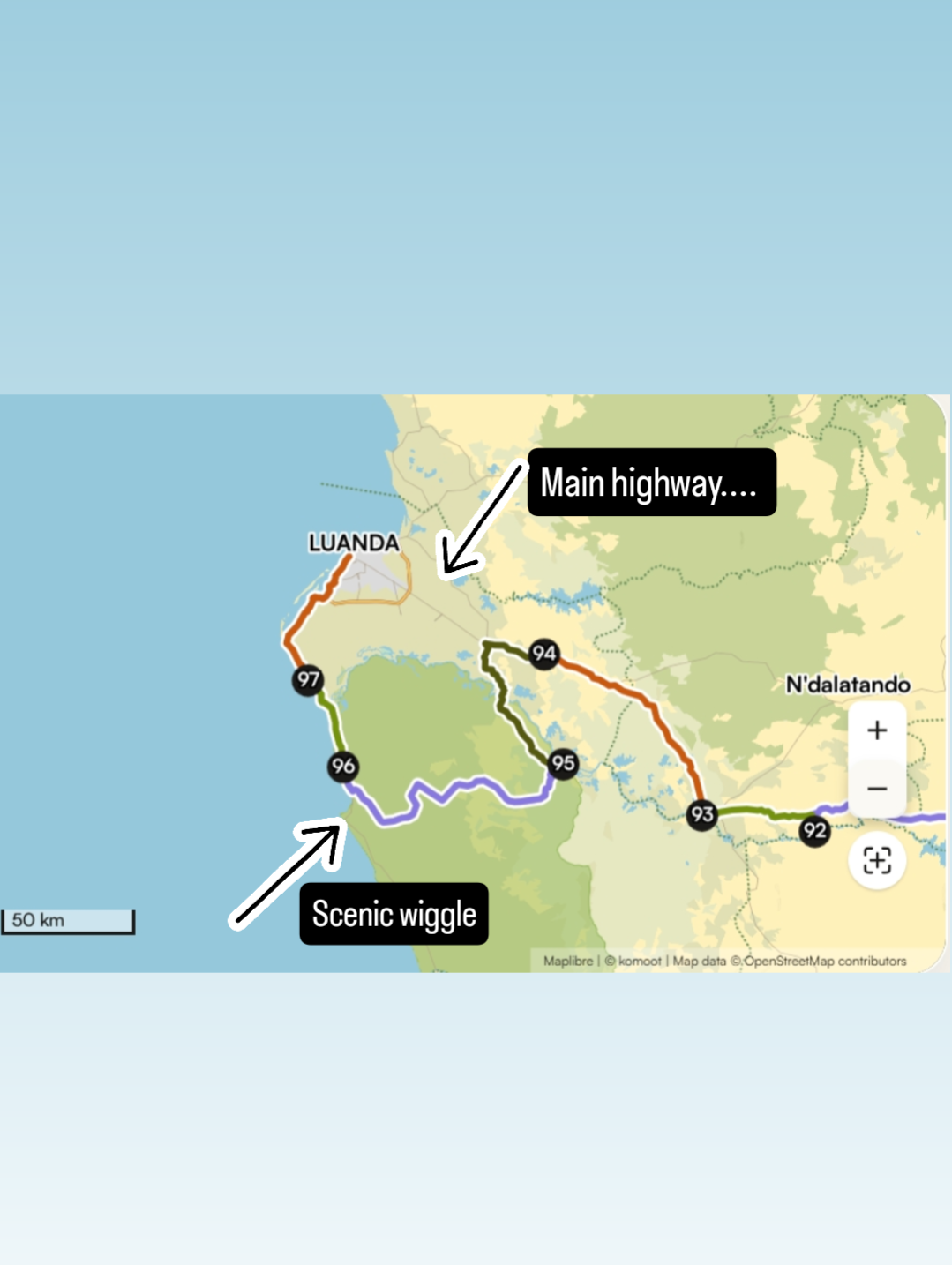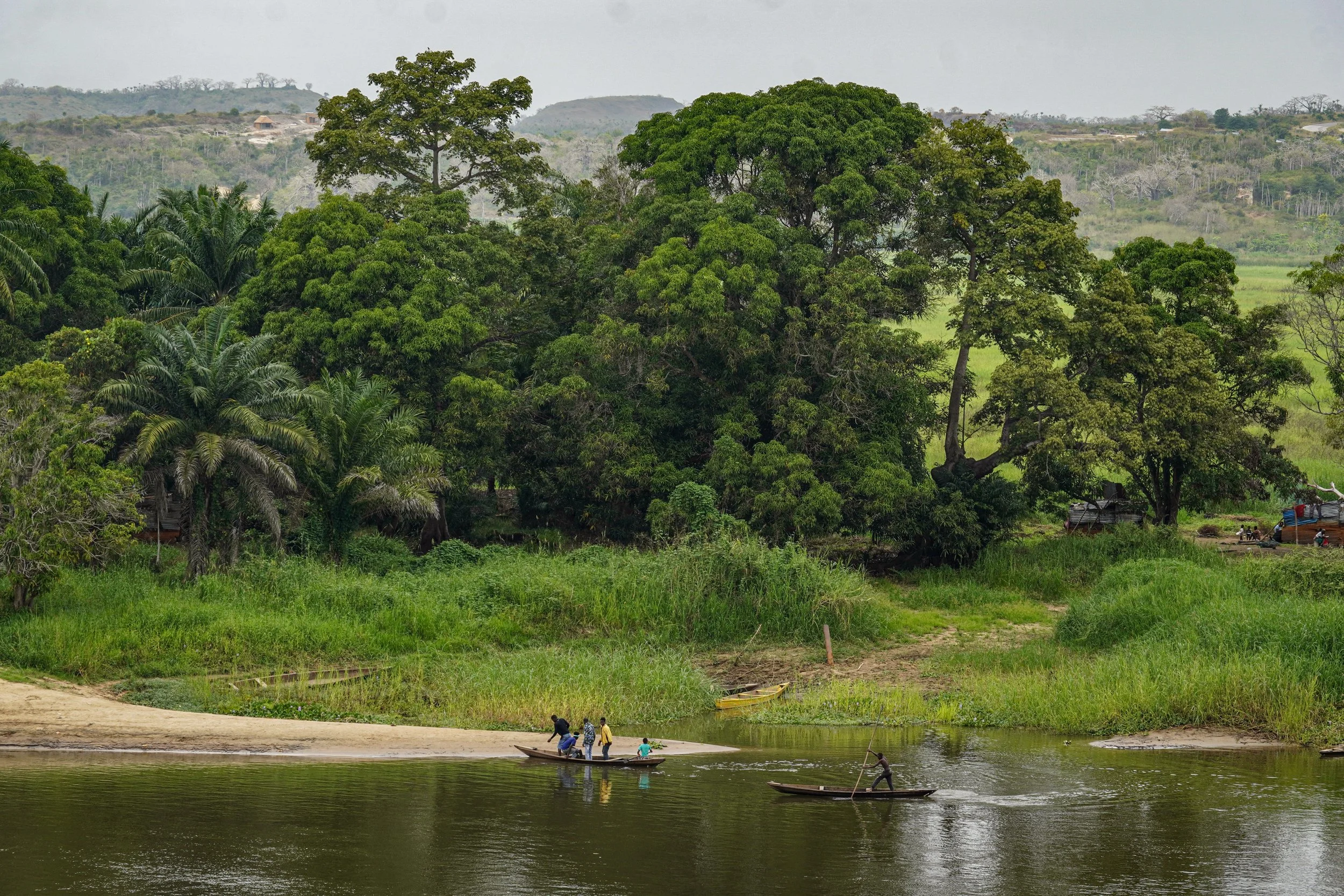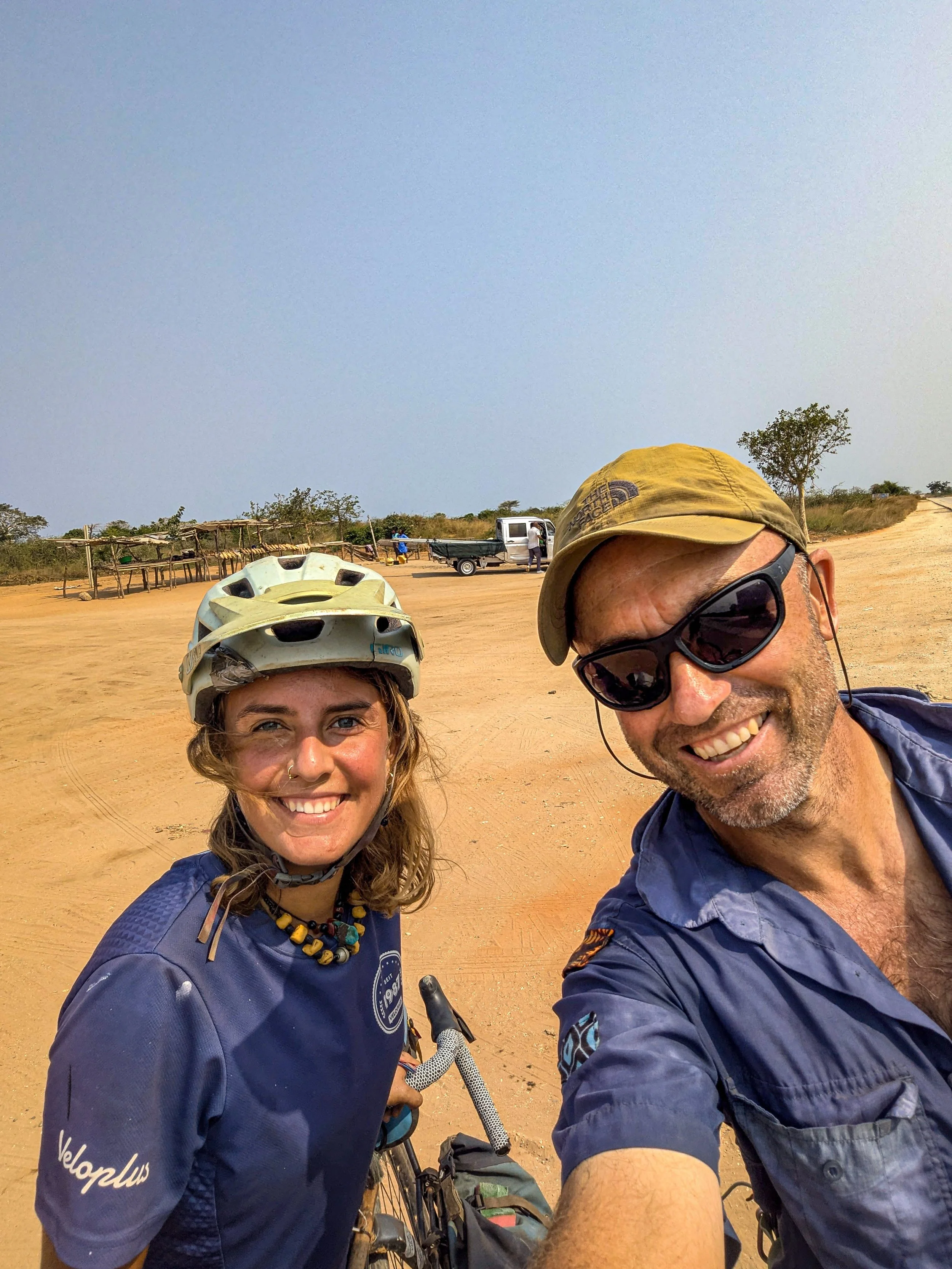Across Africa Part 12: Luanda And The End
Part of me could have happily continued. Cycling through Angola had been such an adventure - the dirt tracks through remote forests, beautiful waterfalls, amazing campsites. And despite my limited Portuguese, people had been warm and friendly.
I never really felt in any danger - perhaps that comes after years of living and travelling on the continent. I always feel that the greatest danger travelling by bicycle is being hit by another vehicle, which is one of the main reasons I always try to find the quietest roads.
With another visa extension I could have rolled south towards and into Namibia, prolong my trip and continue all the way to South Africa and Cape Town perhaps - a much better place to end than Luanda, which I’d read was busy, chaotic, dirty and dangerous - much like most African capitals in my experience. Once you’re attuned to the simplicity and daily rhythm of life on the road it’s really quite simple - in one sense - to keep going.
But I’d already extended my flight ticket twice. Luanda had always been the end point, so cancelling it and booking an entirely new one seemed indulgent. Besides, I’ve cycled in Namibia and South Africa before, and while I’d happily go back, I was also looking forward to arriving back in the UK during summer - not months later when the days are short and the weather mostly grey and cold - a bit like it is as I write this now.
After months of mostly quiet trails and minor roads, there was no way I was going to avoid the traffic that comes with cycling into a rapidly growing city like Luanda, home to over 10 million people. But I did my best to choose what looked like the best route - a little more wiggling on the map to take in a national park, some of the Atlantic coast, and even meet another foreign cyclist - one of the few I’d seen in the last 7 months.
The photos here cover those remaining days as another great adventure in Africa came to an end. I’ll post some more thoughts and statistics from the trip in one final post to come.
The last wiggle. The highway was already becoming too busy 200km away from Luanda, so I headed south towards Quicama National Park, allowing me to reach the coast and travel north to finish in the capital.
Leaving the town of Dondo, where I had spent a few nights. I didn’t really spend enough time in urban areas of Angola to explore its historical and colonial architecture, which exists most often in a state of disrepair.
Dondo had some old streets with a faded colonial charm, which felt like travelling back in time.
I really felt I needed to read more about the history here - both before and during its long civil war - to have a better understanding of the country. Outside of Luanda, finding English speakers in Angola is rare. I resorted to Google translate when I needed to, else relied on some of the simple words and phrases I knew, but I was never going to have an in-depth conversation, as I might have done with someone in Zambia.
While the civil war here was long devastating for Angola, it ended 25 years ago, which for over 65% of the population of the country, is before they were alive (the average age in Angola is 16!). I don’t know how the history of the country is taught to kids here, if they do go to school.
Salaried jobs for most people are few and far between - as they are in many African countries. I had stopped to take a look in the blue bowl on the roadside containing a large fish. A few seconds later this young woman came running out thinking I wanted to buy it. Catfish are relatively common in African rivers (I recall eating such slimy fish on a regular basis when cycling through Central Africa).
This one was being sold at around $4. Full of protein and fat, but not the tastiest of fish.
Now that I had dropped in elevation the roadside had a lot more baobabs- one of Africa’s most iconic trees. The tree bark and the fruit itself have various uses - from producing medicine, to skincare products and making rope.
A feast awaits. I always look forward to eating after a day on the road. On days when I’ve managed to pick up various ingredients, I usually make a sauce of some description, to be eaten alongside pasta (most often) or occasionally rice. Some foreign cyclists make do with street food when travelling in Africa—which is often poor and limited—or only have the energy to cook simple/quick meals like packet noodles, soups, or eggs, especially if they’re carrying just a gas stove (gas canisters can be hard to find in some countries). With my multi-fuel burner, I didn’t care if a meal took 20 minutes or an hour to prepare; fuel was always easily available. The ingredients above were enough for two or more meals.
And I ate that feast beneath this sky and baobab tree. Bottle of red wine and some good company missing!
Back over the River Cuanza the next day and headed south. I crossed Angola’s largest river a number of times on this traverse across the country. Here I was around 120 km from where it empties into the Atlantic.
The River Cuanza is almost 1000 km in length, but only navigable by small boats from the sea for 250km. There is little in the way of large boats on the river owing to sandbanks and shallowness during the dry season.
Located around 150km upstream from the coast is one of Angola’s oldest and certainly most important churches. The Church of Nossa Senhora da Conceição da Muxima was built around 1599 by the Portuguese, alongside a fort which overlooks the river and church. Between the 17th and 19th Century the church was used as a place to baptise slaves, captured from the interior, before being shipped downriver and across the Atlantic to the Americas.
Nowadays it is better known as the site of Angola’s largest pilgrimage, an annual event that sees up to 1 million Catholics come to worship the shrine of Mama Muxima - a wooden statue of the Virgin Mary. The statue is venerated for its supposed miraculous intercessions — especially for protection, healing, and peace.
Not much has changed in that view over the centuries.
The church itself was closed when I visited, with just a few people sitting within the shade outside. I don’t think I would get anywhere near it during August/September when pilgrims arrive.
A short distance away I found a suitable spot to pitch the tent, but was soon inside when hundreds of mosquitoes found me.
This whole area has thousands of beautiful baobabs.
Fast-forward 130 km the following day and I had made it to the coast, just in time for sunset. Most of the day had been spent cycling through Quicama National Park on an empty paved road. Like most national parks in Angola, wildlife was killed during the civil war and animal numbers are far lower than in neighbouring countries like Zambia and Namibia. I saw a few monkeys and baboons - otherwise it was peaceful bush - easy to camp, but I wanted to reach the ocean!
For many weeks I had been imagining the sight of the Atlantic. In West Africa you often hear it before you see it - the sound of the large surf could be heard as I rode to the edge, and what turned out to be another great campsite.
Luanda was only 100km or so north from here - reachable in a day, but I had been chatting online for a few weeks with another foreign cyclist who was riding south from Luanda the next day, so we agreed on a meeting point halfway.
My penultimate camp in Angola was another great one - sleeping and waking to the sound of the surf below.
Camping on the edge. In hindsight perhaps a little further back would have been safer.
The following day I met Aline, from Switzerland. Her solo journey had taken her through west Africa in the months prior to this. She was headed south towards Namibia and South Africa, but we had agreed to camp together. She was only the 2nd foreign cyclist I had met during this 7-month trip - a reflection of both the lower number of people cycling through Africa, but also the routes I had mostly followed. The majority of cyclists I read about often tend to follow major routes and take more direct roads to reach places of interest, rather than minor tracks that are likely to be slower and in worse condition.
Travelling solo as a female brings with it more challenges. Aline reminded me of these as we rode to find somewhere to camp.
Down to the beach. The first person I had camped with on this trip. As a solo woman wild camping in Africa - by which I mean totally alone and not in a village/town next to a school/church with people around (as I’ve done many times too) brings with it more risk. There were many times on this trip, and others, where people (both men and women) may have seen my tent before I went to sleep. I rarely feared this, and if I did have a bad gut feeling, for one reason or another, it’s likely I wouldn’t stay. I don’t know how this would feel as a woman, as I write from a male perspective, but while the concept of camping alone in the bush is already an odd concept for many Africans, doing so as a solo woman is likely to bring with it more attention - whether welcome or not. No woman travels solo through Africa (many places) without unwanted attention from men. Aline had almost always camped within villages/towns (she had no stove for one thing so needed to be sleeping in places where she could get food in the evening) so this was one of her first times camping without an audience.
My last camp on this trip. Nice to have had company before we parted ways later.
Ready to roll. Aline was riding a very different kind of bike to mine. Narrow tyres meant she was almost always on paved roads. It was her first major solo trip and her first time in Africa. She had hoped to get a visa extension in Angola and stay longer, but this was denied as she had not applied for an electronic visa in advance. She continued into Namibia and South Africa, finishing in Cape Town as planned.
Saying goodbye. Just 60km for me to reach Luanda - not a ride I was really looking forward to as the traffic would get busier the closer I got (it was never really that bad). For Aline she headed south along the coast.
And relax. For weeks and months I had been in contact with an Angolan who lived in Luanda. I’d stayed in a hotel that he had booked for me, a company compound connected with the conservation project he was a lead in, and even his mother’s family home in recent weeks where I last had malaria. So when I found out that he had organised accommodation for me in Luanda, because he wasn’t going to be there when I arrived to host me, I felt more disappointment at not getting to meet him, than relief at having to find budget accommodation in what is generally a city with a lack of it.
This guest house was a bit of an oasis in the centre of the city. Owned by a Portuguese/Angolan family, it had plenty of space to relax for a few days and box up my bike for the flight.
The hunt for a bike box. While I had seen very few bicycles in Angola, Luanda catered to those living and working here with a budget to buy a bicycle with a value beyond that of a car. I didn’t cycle in the city at all once I arrived, and other than Ilha de Luanda - a flat strip of land protruding from the city, and largely filled by hotels/residences with astronomically expensive land values, I couldn’t imagine anyone wanting to spend $6000-10,000 on a road bike to cycle here (the prices of those pictured were generally in this price range). Fortunately the bike shop did have a few large boxes for the mountain bikes they had imported here, so I took the largest available.
Somewhat smaller than the one I had used when I flew to Kenya, but it looked wide enough, which was important.
But not long enough to keep my rear tyre on, which I usually do. I ended up having to remove the bottle cages to get both wheels squeezed down the side here. The handlebars were wedged in the front and nothing was moving at all, which in one sense I thought was better than having lots of space and the bike being able to move about.
With the wheels really squeezed in I was worried that the cones might break through the cardboard, so reinforced the box sides with extra cardboard.
An internal geared bicycle like this is much easier to box as there is no worry of damaging the gear system, which would be the case with a derailleur. The belt is left between the chain stays here.
With bike box sorted I had a few days before my flight to see some of Luanda. St Michael’s Fortress dates from 1576, constructed as a military and administrative headquarters of Portuguese Angola.
The views from the fort over the city centre give, in one sense, an impression of a modern and developing financial centre.
With a new seafront promenade for people to exercise and walk. Like most African capitals, and perhaps many capitals around the world, the more upmarket/developed areas could just as well be in a different country entirely.
Interestingly, Angola is ranked as a lower middle-income country, a classification that means that average annual incomes are between $1200-$4400 - a result massively skewed by incomes from oil wealth, which are predominantly concentrated in the capital.
One of the first things I noticed when I arrived in Angola, and something that never really changed during the 2 months I spent here, was how much more noticeably poorer it was, in rural areas, than neighbouring countries like Zambia and Tanzania. I had seen very little investment in critical things like education or healthcare, so lower middle-income really just shows how much inequality exists in the country.
Luanda certainly wasn’t a city I would wish to live in, but I could say the same thing for a number of other African capitals.
I didn’t really explore Luanda in any depth. One of the first impressions I had, aside from the mature and overgrown trees lining some of its roads, was how much the smell of urine permeated the air. Lack/absence of public latrines meant almost every roadside and tree was being used as a toilet - something I witnessed while walking around.
I had considered finding a medical clinic and doing a malaria parasite test, but there was nothing nearby and I ended up just going to a pharmacy to stock up on a few quick test kits and malaria medication should I suddenly start feeling symptoms when I was back in the UK. As I write this several months later, I feel absolutely fine.
Colonel Kurtz. While I never got to meet my Angolan contact Kerllen, who was out on assignment in search of forest elephants in the Angolan forests, I got to meet his father, Sergio, in Luanda. A retired helicopter pilot in the Angolan army, my first impressions on meeting this giant of a man was his resemblance to Marlon Brando in Apocalypse Now. Sergio was kind enough to drive me around Luanda and take me to the airport. Perhaps one day if I return to Angola I’ll get a chance to thank Kerllen in person for his help and assistance during my time in Angola.
Back in London. My flight was with Qatar Airways, meaning that my baggage allowance was the same generous 2x23kg, allowing the bike to be boxed separately (there was little space for anything else) as one piece of luggage, and a laundry bag with my gear the other.
I put the bike back together at the airport and all seemed well, until I rode off and tried to change gear.
The gear shifter, which must have been in direct contact with the forks (the handlebars were squeezed in tight) had broken, meaning that when I tried to change gears the gear cable was just slipping. I managed to ride the 50 km planned that day, before completing the journey home by train. Better this happened at the end of a trip than the beginning!
I’ve flown many times with a bike and never had a problem. While I initially thought having a smaller box was advantageous (no room for the bike to move around) I think this box was just a bit on the small side, but it was the largest one available.
Enjoyed this post? You can support my travels and ongoing content creation by clicking on the link below. It’s a great motivation to continue sharing. Thanks










































